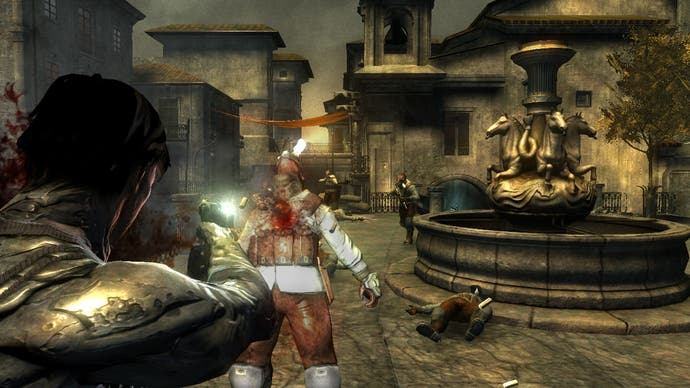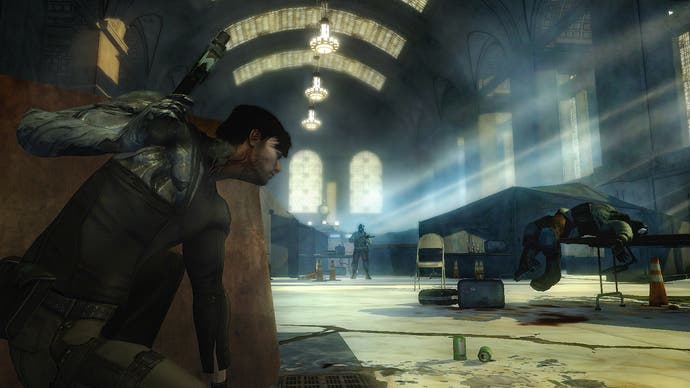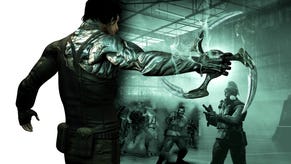Dark Sector
They mostly come out at night. Mostly.
Okay, ladies, here's the low-down. New game from Digital Extremes - the studio which was joined at the hip to Epic Games for years. It worked on Unreal, Unreal Tournament, and a bunch of other stuff with Unreal in the name. Following a successful operation to split the conjoined twins, the team struck out to make games without Unreal in the name.
In other words, this one should be by the numbers. It won't take a moment of your time. We'll get in, talk a bit about burly marines with necks thicker than your waist, touch on the many different ways of splattering alien scum all over the walls, and make a few jibes about the American obsession with intensely homoerotic male-jock-bonding scenes (perhaps asking whether Gears of War is responsible for the current review of the Don't Ask, Don't Tell policy). This is what Epic Games and its (former) partner studios do.
First impressions say we're right. You're playing a sci-fi looking chap with a massive spiky metal glaive which you use to take down soldiers and monsters in a dark, gloomy, dystopian city environment. This is familiar territory. We'll wrap up this preview in no time at all.
Right then, let's get on then. First question to the chap showing off the game; what games would he say are the major influences on Dark Sector? We've almost started writing "Gears of War" on our notepad by the time he opens his mouth.
"Zelda, definitely," he says, without a moment's hesitation.
Oh.
Missing Link?

Well, that was unexpected. Let's back up a moment and explain our now-tattered looking prejudices about Dark Sector. The game stars a chap called Hayden, a nasty, immoral CIA black ops agent who is sent in to track down a Cold War era scientist in a city somewhere inside the former Soviet Union. However, he's caught up in all manner of unpleasantness when it transpires that the scientist's creation - a virus which mutates living creatures it touches into metallic "living weapons" - is released in the city, which is promptly sealed off by the army. Hayden himself is attacked, and wakes up to find that he's now got a shiny metal arm and a bunch of new abilities.
Primary among those is the ability to sprout a three-pronged and incredibly sharp metal glaive from his fist, which he can then use to stab and slash his enemies. Alternatively, he can hurl it at them from a distance, giving him, in effect, a built-in and very powerful weapon which makes the various guns he picks up into side-shows - the glaive itself is the main event. As for those enemies, well, there are plenty of them. Halfway between metallic monster and human, he's assaulted by both the monsters and the soldiers who are attempting to contain them, which is a convenient setup for shooting every damn thing in sight.
So far, so... So generic, frankly, but it's undeniable that Dark Sector does it all with a certain panache. Graphically, the game is a stunner. Beautiful light and shadow effects abound, smoke and fog react realistically to movement, and an interesting artistic theme blends Eastern European architecture and city design with organic-looking corruption which gradually encroaches on the city. Originally conceived as a PC title, the game is now destined for Xbox 360 and PS3 (the PC version was canned because the Digital Extremes chaps were unimpressed by the strength of that market), and looks set to take full advantage of the next-gen graphics hardware.
In fact, the best comparison graphically - despite the obvious parallels with Half Life 2's City 17 in the setting - is none other than Gears of War, with its often-touted "destroyed beauty" motif. The game looks as graphically impressive as the bulk of titles served up on the Unreal Engine 3 platter, although in a surprising move, Digital Extremes chose to develop its own graphics engine from scratch for Dark Sector. Despite the team's obvious familiarity with Epic's technology, Dark Sector uses none of it; apparently the Unreal Engine simply wasn't finished at the time when the game entered full development, so it wasn't an option.
Everything about the presentation of the game suggests that this should be another balls-out American action title - but once we get a chance to see contiguous sections of gameplay, rather than merely clips of people being gutted by Hayden's stabby glaive, the seemingly bizarre Zelda reference makes more sense. As does another...
Hand of the Dead

"We really liked Resident Evil 4 too," our presenter tells us. "We looked at that a lot." Here, the comparison is a bit more obvious. For all its American FPS overtones, Dark Sector borrows its camera angle from Capcom's masterpiece - and much of its control system, too. None of the heavily action focused running and diving of Gears of War here; Hayden is a powerful character with fluid, sleek animation, but combat in Dark Sector owes more to the slightly slower and more considered pace of Resident Evil 4 than it does to FPS titles, or even to Gears' over-the-shoulder carnage.
This camera angle, we're told, was chosen because it allows you to get closer to the character - you see more of their actions, identify more closely with what they're doing. Moreover, it simply looks cool - what's the point in creating great animation for your lead character if all you ever see is the back of their head? Hayden is important to Dark Sector, and to Digital Extremes' future plans for the game. They talk openly about this game as being the "origin story of a superhero", and hint that Hayden's abilities will evolve as you play through the game - as will his personality. All of the signs point towards hopes of a franchise.
The camera angle also gives you a clearer view of the world you're interacting with - which is important for the puzzles. We mentioned already that Hayden's main weapon is his glaive, and while he can pick up guns, it's his innate abilities which are at the core of the game, to the extent that when a gun runs out of ammo, he throws it aside. Guns are a snack between glaive kills. Crucially, the glaive - and Hayden's other abilities, which remain under wraps for now - are also used for solving puzzles.
In essence, the glaive is like a lethal boomerang - when thrown, it arcs out from you and then returns, damaging everything in its path. However, it can also pick up attributes from the things it hits - so if you throw it through fire, it will burst into flames, and can be used to set things alight. Thrown at a light fitting or a fuse box, it will return with a powerful electrical charge surging through the blades; thrown into darkness, it will illuminate your path like a moving torch. These attributes (and Digital Extremes hints at others - we've only seen early levels so far) combine to build puzzles.
Sometimes, those puzzles are combat shortcuts - setting enemy soldiers on fire or electrocuting them is a swift way to dispose of them. However, other times there's a chaining puzzle to be solved before you progress - and it's here that we suddenly realise that Dark Sector really is designed to be Zelda's cousin, the dark-haired, gothy cousin who nearly gave Zelda's aunt a heart attack by getting a facial tattoo, wears too much eyeliner and swelters in black clothes even in summer.
Puzzle Box

Take this as an example. Hayden walks into a building and clears out some enemy soldiers, only to be stopped by a taut web of organic substance (called "technosyte") across the entry to the next area. Technosyte can't be cut by his glaive, but it shrivels away from fire. He could throw his glaive into something burning and then at the technosyte, but there's nothing burning nearby. There is, however, a gas pipe leaking - and nearby, there's a fuse box. Charge the glaive at the fuse box, throw it into the gas, and you have a burning flame; then ignite the glaive on the flame and throw it at the webbing to clear your path.
It's a simple chaining puzzle, but it supplies a glimpse of the sort of logical chains Dark Sector aims to throw at players. Like Zelda, the world is built up from a sequence of puzzle building blocks; simple items of logic which become more complex as they stack up. Ammunition crates, for example, can't be cleared with normal attacks - but a burning glaive will penetrate the box and detonate the contents. Then there's the physics to take into account, with realistic object physics providing yet more possibilities for interesting, challenging puzzles. Digital Extremes describes it as the inverse of Zelda, in a sense; where Zelda uses combat to break up the puzzles, Dark Sector will use puzzles to break up the combat. If the puzzles can match even Zelda's simpler dungeons, it'll be an intriguing step for such an overtly combat-themed game.
Another interesting step which brings Dark Sector down the Action RPG path is the addition of a massive sub-plot regarding an underground railway which is trying to get uninfected civilians out of the city, past the army barricades. Hayden will encounter plenty of civilians on his journey through the city - and optionally, you can interact with them in a variety of ways. Some of them will ask you to find out what happened to friends of relatives, and will be pleased if you can bring them news or mementos of their loved ones - while others may need your help. The soldiers in the city aren't above using civilians as bait for monsters, for example, and saving civilians from danger will stand in your favour, as only through civilians will you have access to the thriving black market in the doomed city.

This, to a major degree, is part of Hayden's character arc - the whole "superhero origin story" Digital Extremes is so happy to bang on about. The game, too, progresses as you move forward - you start off fighting soldiers, but as the city changes around you and you explore the branching paths of the storyline, your opponents will gradually become more monstrous as the virus takes hold in the population. It's hardly a new mechanic, but the idea of the enemies actually evolving as you progress (rather than simply becoming tougher for no good reason, as they do in many games) is an interesting one.
Darkness Falls
Digital Extremes' portfolio in the years after working on Unreal may not be the world's finest - the team's only work since then was on Xbox and PC title Pariah and its budget-priced follow-up Warpath, neither of which scored review scores anywhere above the waterline of mediocrity. However, Dark Sector has spent a long time in gestation (and has changed vastly in that time), and the game's willingness to look beyond other action titles for its influences is hugely promising.
If nothing else, the game looks like being a graphically stunning and extremely competent third person sci-fi action game. However, it could be so much more. The marriage of Zelda's gameplay sensibilities to the dark, brooding atmosphere and high-octane combat of this genre is one which sounds better and better the more you consider it. We were wrong; Dark Sector isn't by the numbers. If the developer is brave and talented enough to make sure that it stays that way, then come autumn next-gen console owners could be greeting one of the year's best action titles.





.png?width=291&height=164&fit=crop&quality=80&format=jpg&auto=webp)



